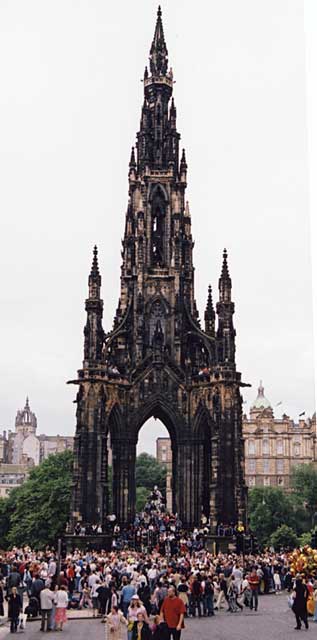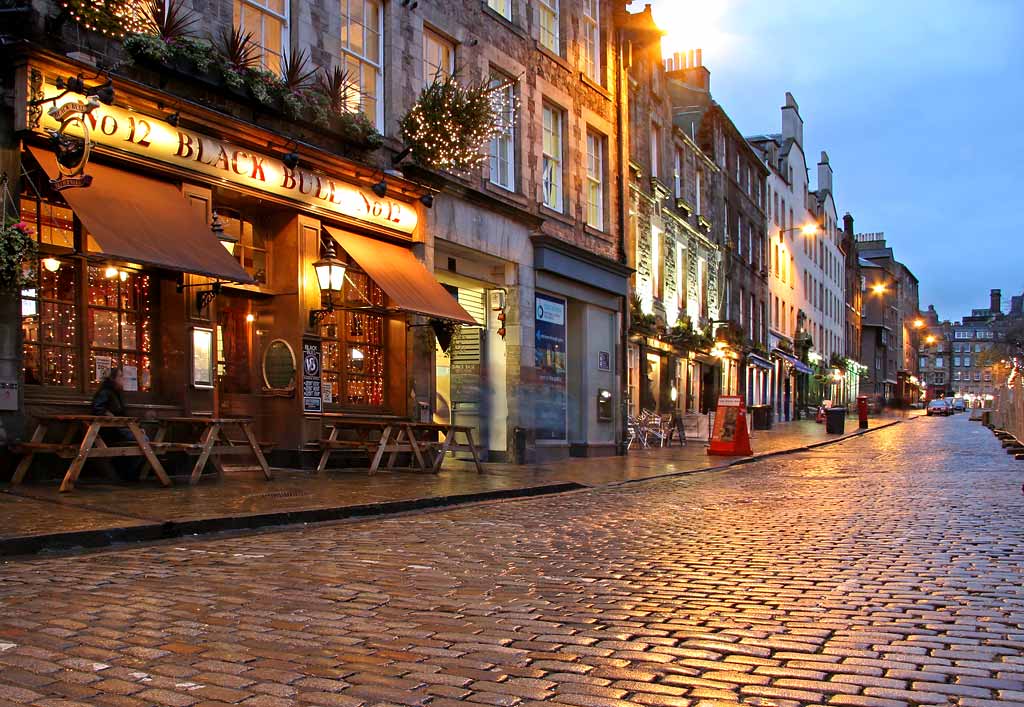Edinburgh is the capital city of Scotland and the seat of the Scottish Parliament. It is the second largest city in Scotland and the seventh most populous in the United Kingdom.
The Old Town and New Town districts of Edinburgh were listed as a UNESCO World Heritage Site in 1995 in recognition of the unique character of the Medieval Old Town and the planned Georgian New Town. It covers both the Old and New Towns together with the Dean Village and the Calton Hill areas. There are over 4,500 listed buildings within the city.
From the atmospheric cobbled streets of the Old Town to the beautiful Georgian avenues of the New Town, Edinburgh is a city of contrasts blending shopping, historic attractions, gardens and plenty of restaurants and cafes where you can relax.
The Old Town has preserved its medieval plan and many Reformation-era buildings. One end is closed by the castle and the main artery The High Street (or the Royal Mile) leads away from it; minor streets (called closes or wynds) bud off the main spine in a herringbone pattern.
Large squares mark the location of markets or surround major public buildings such as St Giles Cathedral and the Law Courts. Other notable places of interest nearby include the Royal Museum of Scotland, Surgeons' Hall, the Royal Festival Theatre, and the University of Edinburgh. The street layout, typical of the old quarters of many northern European cities, is made especially picturesque in Edinburgh, where the castle perches on top of a rocky crag, the remnants of a dormant volcano, and the main street runs down the crest of a ridge from it.
 |
| The Royal Mile |
The topography for the city is known as "crag and tail" and was created during the ice age when receding glaciers scored across the land pushing soft soil aside but being split by harder crags of volcaninc rock. The hilltop crag was the earliest part of the city to develop, becoming fortified and eventually developing into the current Edinburgh Castle. The rest of the city grew slowly down the tail of land from the Castle Rock. This was an easily defended spot with marshland on the south and a loch, the Nor Loch, on the north. Access up the main road to the settlement therefore was restricted by means of various gates and a City Wall (now mostly gone).
Due to the space restrictions imposed by the narrowness of the "tail" the Old Town became home to some of the earliest "high rise" residential buildings. Multi-story dwellings were the norm from the 1500s onwards. During the 1700s the Old Town had a population of about 80,000 residents. However, in more modern times it had declined dramatically to just 4,000 residents.
 |
| City Chambers, Royal Mile |
There are currently approximately 20,000 residents in the various parts of the Old Town. As the population was for a long time reluctant to build outside the defensive wall, the need for housing grew and hence the buildings became higher and higher. However, many of these buildings were destroyed in the Great Fire of 1824. They were then rebuilt on the original foundations. This led to changes in the ground level and the creation of many passages and vaults under the Old Town.
 Edinburgh's New Town is not that new. Built in the mid-to-late 18th Century, in response to overcrowding in what is now known as the Old Town, Edinburgh's New Town is a marvel of urban planning, combining elegant architecture with spacious and comfortable housing.
Edinburgh's New Town is not that new. Built in the mid-to-late 18th Century, in response to overcrowding in what is now known as the Old Town, Edinburgh's New Town is a marvel of urban planning, combining elegant architecture with spacious and comfortable housing.New Town buildings are typically of a neo-classical style sometimes even with grandiose, graecian pillars outside and tall ceilings and decorative friezes and trimmings inside.
The interiors of most New Town residences, have been modernised as flats and office spaces. Even the mews buildings, that once housed servants and stables, are considered desirable properties.
However, the original character of the Georgian era New Town, with its cobbled roads, pillars, and sandstone block facades is preserved today thanks to building codes that stipulate even the wrought iron railings must be painted a specific colour - black.

Edinburgh’s Top 5:
 |
- Edinburgh Castle . Edinburgh Castle is visited annually by approximately one million people - if we except the Tower of London that is more people than visit any other ancient monument in the United Kingdom. Every visitor - particularly those on a restricted itinerary - should visit the Castle, not only because of the historical interest of this remarkable fortress and former royal residence, but because it offers such splendid panoramic views of the city. It is from these battlements, for example, that the traveller immediately appreciates the dramatic topography of Edinburgh, situated between sea and hills. Within the confines of the Castle, there is much to see. It was the seat (and regular refuge) of Scottish Kings, and the historical apartments include the Great Hall, which now houses an interesting collection of weapons and armour.No one is sure who first used the castle rock as a settlement, but it was long before the Romans came sailing up the Forth and landing at Cramond.
The oldest building in all Edinburgh is to be found within the Castle precincts. It is St. Margaret's Chapel, a tiny Norman building which has been standing there intact for more than 900 years. It has survived all the sieges and bombardments to which the fortress on the rock was subjected during that period. On several occasions the castle was razed - but the demolishers invariably spared the chapel of the good St Margaret because of its religious significance.
The Scott Monument - The Royal Mile. The Royal Mile sits at the heart of Edinburgh and connects the castle withth Palace of Holyrood House. The Mile is overlooked by impressive, towering tenemants between which closes and stairways help to create a secret underground world. Peppered with superb attractions such as The Real Mary King's Close, historical sites such as St Giles Cathedral, wonderful shops and some of the best eating and drinking spots in the city there is so much to do and see. For recent history, be sure to visit the impressive Scottish Parliament building with its ultra-modern cutting edge design.
- Grassmarket. Once a medieval market place and site for public executions, the Grassmarket is now a vibrant meeting place bursting with lively drinking spots and eclectic shops. Loved by students,tourists and locals alike, as with all of Edinburgh, be sure to look upwards and admire the architecture and stunning views of the castle. Though executions ceased here in 1784, some of the traditional Grassmarket pubs such as The Last Drop and Maggie Dixon's keep alive the bloody history. The modern entertainment in Grassmarket centres around daily live music and acoustic performances.
- Holyrood House. The Palace of Holyrood House, the official residence in Scotland of Her Majesty The Queen, stands at the end of Edinburgh's Royal Mile against the spectacular backdrop of Arthur's Seat, this fine Baroque palace is closely associated with Scotland's rich history. The palace is probably best known as the home of Mary, Queen of Scots and as the setting for many of the dramatic episodes in her turbulent reign. The palace briefly served as the headquarters of Bonnie Prince Charlie during the 1745 uprising.
Princes Street. Where else can you experience fantastic shopping while enjoying uninterrupted views of an ancient fortress perched atop a giant volcanic rock?. Admire these stunning views as you browse its comprehensive selection of High street and designer brands . Large shopping centres and old fashioned department stores jostle for position among souvenir shops and food outlets. For a mesmerising view of the city, climb the 287 steps to the top of the Scott monument and visit world renowned works of art at The National Gallery of Scotland.
Grassmarket
References: http://www.edinburgh-scotland.net
http://www.edinburgh.org/
http://www.edinburghguide.com
peter.stubbs@edinphoto.org.uk
http://www.pbase.com/wangi/image/41599998

No comments:
Post a Comment